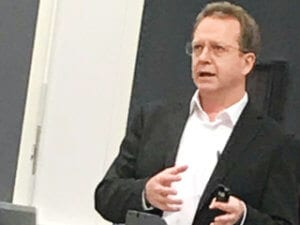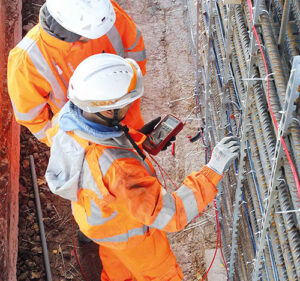The February talk was on the use of Electrochemical Impedance Spectroscopy (EIS) as a predictive tool for coating lifetime, and was given by Dustin Traylor, Global Product Manager of Axalta Coatings Systems. This was an excellent presentation which produced significant discussion amongst those attending. The concept was to raise awareness of new predictive modelling techniques for coating life and performance. A new generation of high temperature coatings, in particular high glass transition temperature Fusion Bonded Epoxy (with a Tg of 205 C), are being developed as a lower cost alternative to expensive alloy steels. However, the highly-functional epoxy resin and ingredients in these new coatings can make interpretation of testing results difficult for coating specifiers. Dustin explored the benefits of using EIS after atmospheric testing to assess a coating’s life expectancy. The conclusion was that EIS did have a part to play in conjunction with accelerated weathering, Autoclave and Atlas Cell tests, to assist in the determination of expected coating life. This technique has now been adopted by Aramco and Chevron and is gaining credibility as a useful tool in the pipeline market.
The branch AGM was held ahead of the March evening technical meeting, at which David Mobbs (Chair) delivered a short presentation on the achievements of the branch over the past year, including confirming that the move to Imperial College had increased attendance from 20-30 to 40-50 per meeting, and that our finances were good. He outlined the steps being taken to obtain speakers to present new technology, new ideas and having more technical content, and noted that the membership affiliated to the branch amounts to 45% of Institute members, and 22 members qualified for 20 or 30 years long service pins. He finished by thanking everyone for their support, and the speakers and committee members who give up their time voluntarily to make it all work.
Mark Stone of Sonomatic Ltd then gave a presentation
on the technology advancements in integrity management
of storage tanks. The industry is well versed with non-intrusive inspection of vessels and pipework, but corrosion mapping of storage tanks has always relied on man entry and physical base plate inspection. However, the industry does not like working in confined spaces and there are moves towards zero-man entry over the lifetime of storage and process vessels. Mark explained that tank inspection plays a major role in effective integrity management of storage tanks, which historically has relied on emptying the tank and personnel entry for cleaning and inspection, and that the common method of using Magnetic Flux Leakage testing is not necessarily the most effective method of determining metal loss. Sonomatic have developed a range of methods for inspection of these tanks while in-service, which includes the use of traditional shell wall inspection using crawlers, coupled with a new technology to determine metal loss of the tank shell using multi skip technology deployed around the outer chine of the tank.
The key element of this testing programme is the use of robotic cleaning and inspection of the floor – the tool is dropped through the tank fluids to the floor and remotely guided by use of sonar. Firstly the level of sludge is determined, and then the tool removes this and scans the base plates, the results of which are transmitted to a mobile unit outside the tank where a statistical analysis is carried out. The presentation included a case study of a field application.

Mark Stone of Sonomatic
This was an excellent presentation and there was a high level of discussion around the floor. The chairman’s opinion was that the real value of this testing procedure was that it was an ‘iterative process’, whereby a tank farm operator could screen all the tanks and identify which were detected as the worst. On opening the tank and carrying out full base plate inspection it would be possible to check the model to see how accurate it was, and by the time the third tank had completed its full inspection, the model would be pretty accurate, and could be used in future with more certainly.




